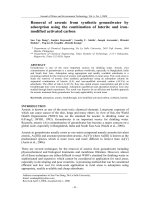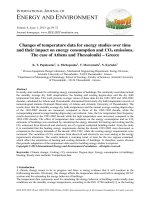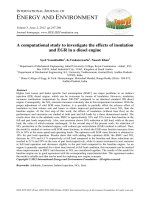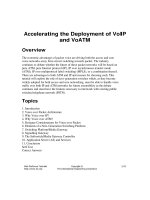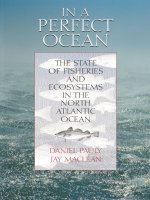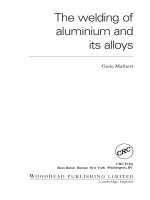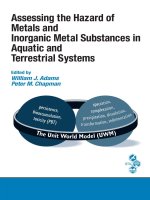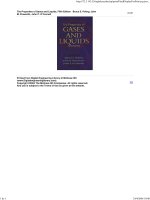the geometry of hamilton and lagrange spaces - miron, hrimiuc, shimara, sabau.
Bạn đang xem bản rút gọn của tài liệu. Xem và tải ngay bản đầy đủ của tài liệu tại đây (5.48 MB, 352 trang )
The Geometry
of Hamilton
and Lagrange Spaces
by
Radu Miron
Al. I. Cuza University,
Romania
Hrimiuc
University of Alberta,
Edmonton, Canada
Hideo Shimada
Hokkaido Tokai University,
Sapporo, Japan
and
Sorin V. Sabau
Tokyo Metropolitan University,
Tokyo, Japan
KLUWER ACADEMIC PUBLISHERS
NEW YORK, BOSTON, DORDRECHT, LONDON, MOSCOW
eBook ISBN: 0-306-47135-3
Print ISBN: 0-792-36926-2
©2002 Kluwer Academic Publishers
New York, Boston, Dordrecht, London, Moscow
Print ©2001 Kluwer Academic Publishers
All rights reserved
No part of this eBook may be reproduced or transmitted in any form or by any means, electronic,
mechanical, recording, or otherwise, without written consent from the Publisher
Created in the United States of America
Visit Kluwer Online at:
and Kluwer's eBookstore at:
Contents
Preface
IX
1 The geometry of tangent bundle
1
1.1
1.2
1.3
1.4
1.5
1.6
1.7
1.8
1.9
The manifold TM .
Homogeneity
Semisprays on the manifold
Nonlinear connections
The structures
d-tensor Algebra
N-linear
connections
Torsion and curvature
Parallelism. Structure equations
1
4
7
9
13
18
20
23
26
2 Finsler spaces
31
2.1
2.2
2.3
2.4
2.5
2.6
2.7
2.8
2.9
Finsler metrics
Geometric objects of the space
Geodesics
Canonical spray. Cartan nonlinear connection
Metrical Cartan connection
Parallelism. Structure equations
Remarkable connections of Finsler spaces
Special Finsler manifolds
Almost Kählerian model of a Finsler manifold
31
34
38
40
42
45
48
49
55
3 Lagrange spaces
3.1
3.2
3.3
3.4
3.5
3.6
The notion of Lagrange space
Variational problem Euler–Lagrange equations
Canonical semispray. Nonlinear connection
Hamilton–Jacobi equations
The structures and of the Lagrange space
The almost Kählerian model of the space
63
63
65
67
70
71
73
VI
3.7
3.8
3.9
3.10
Metrical N–linear connections
Gravitational and electromagnetic fields
The Lagrange space of electrodynamics
Generalized Lagrange spaces
75
80
83
84
4 The geometry of cotangent bundle
87
4.1
4.2
4.3
4.4
4.5
4.6
4.7
4.8
4.9
4.10
4.11
4.12
The bundle
The Poisson brackets. The Hamiltonian systems
Homogeneity
Nonlinear connections
Distinguished vector and covector fields
The almost product structure The metrical structure
The almost complex structure
d-tensor algebra. N-linear connections
Torsion and curvature
The coefficients of an N-linear connection
The
local
expressions
of
d-tensors
of
torsion
and
curvature
Parallelism. Horizontal and vertical paths
Structure equations of an N-linear connection. Bianchi identities
. . .
87
89
93
96
99
101
103
106
107
110
112
116
5 Hamilton spaces
119
5.1
5.2
5.3
5.4
5.5
5.6
5.7
5.8
5.9
5.10
The spaces
N–metrical connections in
The N–lift of
Hamilton spaces
Canonical nonlinear connection of the space
The canonical metrical connection of Hamilton space
Structure equations of Bianchi identities
Parallelism. Horizontal and vertical paths
The Hamilton spaces of electrodynamics
The almost Kählerian model of an Hamilton space
119
121
123
124
127
128
130
131
133
136
6 Cartan spaces
139
6.1
6.2
6.3
6.4
6.5
6.6
6.7
6.8
The notion of Cartan space
Properties of the fundamental function K of Cartan space
Canonical nonlinear connection of a Cartan space
The canonical metrical connection
Structure equations. Bianchi identities
Special N-linear connections of Cartan space
Some special Cartan spaces
Parallelism in Cartan space. Horizontal and vertical paths
139
142
143
144
148
150
152
154
VII
6.9
The almost Kählerian model of a Cartan space
156
7 The duality between Lagrange and Hamilton spaces
159
7.1
7.2
7.3
7.4
7.5
7.6
The Lagrange-Hamilton duality
–dual nonlinear connections
–dual d–connections
The Finsler–Cartan –duality
Berwald connection for Cartan spaces. Landsberg and Berwald spaces.
Locally Minkowski spaces.
Applications of the -duality
159
163
168
173
179
184
8 Symplectic transformations of the differential geometry of
189
8.1
8.2
8.3
8.4
8.5
8.6
8.7
Connection-pairs on cotangent bundle
Special Linear Connections on
The homogeneous case
f -related connection-pairs
f-related connections
The geometry of a homogeneous contact transformation
Examples
189
195
201
204
210
212
216
9 The dual bundle of a k-osculator bundle
219
9.1
9.2
9.3
9.4
9.5
9.6
9.7
9.8
9.9
The bundle
The dual of the 2–osculator bundle
Dual semisprays on
Homogeneity
Nonlinear connections
Distinguished vector and covector fields
Lie brackets. Exterior differentials
The almost product structure The almost contact structure . . .
The Riemannian structures on
220
227
231
234
237
239
242
244
246
10 Linear connections on the manifold
10.1
10.2
10.3
10.4
10.5
10.6
10.7
10.8
The d–Tensor Algebra
N-linear
connections
Torsion and curvature
The coefficients of an N-linear connection
The h-, covariant derivatives in local adapted basis
Ricci identities. The local expressions of curvature and torsion.
Parallelism of the vector fields on the manifold
Structure equations of an N–linear connection
249
249
250
253
255
256
259
263
267
VIII
11 Generalized Hamilton spaces
of order 2
271
11.1
11.2
11.3
11.4
The spaces
Metrical connections in –spaces
The lift of a GH–metric
Examples of spaces
271
274
277
280
12 Hamilton spaces of order 2
283
12.1
12.2
12.3
12.4
12.5
12.6
12.7
12.8
12.9
The spaces
Canonical presymplectic structures and canonical Poisson structures .
Lagrange spaces of order two
Variational problem in the spaces
Legendre mapping determined by a space
Legendre mapping determined by
Canonical nonlinear connection of the space
Canonical metrical N connection of space
The Hamilton spaces of electrodynamics
283
286
290
293
296
299
301
302
304
13 Cartan spaces of order 2
307
13.1
13.2
13.3
13.4
13.5
13.6
–spaces
Canonical presymplectic structure of space
Canonical nonlinear connection of
Canonical metrical connection of space
Parallelism of vector fields. Structure equations of
Riemannian almost contact structure of a space
307
309
312
314
317
319
Bibliography 323
Index 336
PREFACE
The title of this book is no surprise for people working in the field of Analytical
Mechanics. However, the geometric concepts of Lagrange space and Hamilton space
are completely new.
The geometry of Lagrange spaces, introduced and studied in [76],[96], was exten-
sively examined in the last two decades by geometers and physicists from Canada,
Germany, Hungary, Italy, Japan, Romania, Russia and U.S.A. Many international
conferences were devoted to debate this subject, proceedings and monographs were
published [10], [18], [112], [113], A large area of applicability of this geometry is
suggested by the connections to Biology, Mechanics, and Physics and also by its
general setting as a generalization of Finsler and Riemannian geometries.
The concept of Hamilton space, introduced in [105], [101] was intensively studied
in [63], [66], [97], and it has been successful, as a geometric theory of the Hamil-
tonian function the fundamental entity in Mechanics and Physics. The classical
Legendre’s duality makes possible a natural connection between Lagrange and Ha-
milton spaces. It reveals new concepts and geometrical objects of Hamilton spaces
that are dual to those which are similar in Lagrange spaces. Following this duality
Cartan spaces introduced and studied in [98], [99], , are, roughly speaking, the
Legendre duals of certain Finsler spaces [98], [66], [67]. The above arguments make
this monograph a continuation of [106], [113], emphasizing the Hamilton geometry.
*
* *
The first chapter is an overview of the geometriy of the tangent bundle. Due to its
special geometrical structure, TM, furnishes basic tools that play an important role
in our study: the Liouville vector field C, the almost tangent structure J, the concept
of semispray. In the text, new geometrical structures and notions will be introduced.
By far, the concept of nonlinear connection is central in our investigations.
Chapter 2 is a brief review of some background material on Finsler spaces, in-
cluded not only because we need them later to explain some extensions of the subject,
but also using them as duals of Cartan spaces.
Some generalizations of Finsler geometry have been proposed in the last three
decades by relaxing requirements in the definition of Finsler metric. In the Lagran-
IX
X The Geometry of Hamilton & Lagrange Spaces
ge geometry, discussed in Chapter 3, the metric tensor is obtained by taking the
Hessian with respect to the tangential coordinates of a smooth function L defined
on the tangent bundle. This function is called a regular Lagrangian provided the
Hessian is nondegenerate, and no other conditions are envisaged.
Many aspects of the theory of Finsler manifolds apply equally well to Lagran-
ge spaces. However, a lot of problems may be totally different, especially those
concerning the geometry of the base space M. For instance, because of lack of the
homogeneity condition, the length of a curve on M, if defined as usual for Fin-
sler manifolds, will depend on the parametrization of the curve, which may not be
satisfactory.
In spite of this a Lagrange space has been certified as an excellent model for
some important problems in Relativity, Gauge Theory, and Electromagnetism. The
geometry of Lagrange spaces gives a model for both the gravitational and electro-
magnetic field in a very natural blending of the geometrical structures of the space
with the characteristic properties of these physical fields.
A Lagrange space is a pair where
is a regular
Lagrangian.
For every smooth parametrized curve the action integral may be
considered:
A geodesic of the Lagrange Space
(
M
,
L
)
is an extremal curve of the action integral.
This is, in fact, a solution of the Euler–Lagrange system of equations
where is a local coordinate expression of c.
This system is equivalent to
where
and
Here
are the components of a semispray that generates a notable nonlinear con-
nection, called canonical, whose coefficients are given by
Preface XI
This nonlinear connection plays a fundamental role in the study of the geometry of
TM. It generates a splitting of the double tangent bundle
which makes possible the investigation of the geometry of TM in an elegant way, by
using tools of Finsler Spaces. We mention that when L is the square of a function
on TM, positively 1–homogeneous in the tangential coordinates (L is generated by
a Finsler metric), this nonlinear connection is just the classical Cartan nonlinear
connection of a Finsler space.
An other canonical linear connection, called distinguished, may be considered.
This connection preserves the above decomposition of the double tangent bundle and
moreover, it is metrical with respect to the metric tensor When L is generated
by a Finsler metric, this linear connection is just the famous Cartan’s metrical linear
connection of a Finsler space.
Starting with these geometrical objects, the entire geometry of TM can be ob-
tained by studying the curvature and torsion tensors, structure equations, geodesics,
etc. Also, a regular Lagrangian makes TM
,
in a natural way, a hermitian pseudo-
riemannian symplectic manifold with an almost symplectic structure.
Many results on the tangent bundle do not depend on a particular fundamental
function L, but on a metric tensor field. For instance, if is a Riemannian
metric on M and is a function depending explicitly on as well as directional
variables then, for example,
cannot be derived from a Lagrangian, provided Such situations are often
encountered in the relativistic optics. These considerations motivate our investiga-
tion made on the geometry of a pair where is a nondegenerate,
symmetric, constant signature d–tensor field on TM (i.e. transform as a
tensor field on
M
). These spaces, called generalized Lagrange spaces [96], [113], are
in some situations more flexible than that of Finsler or Lagrange space because of
the variety of possible selection for The geometric model of a generalized
Lagrange space is an almost Hermitian space which, generally, is not reducible to
an almost Kählerian space. These spaces, are briefly discussed in section 3.10.
Chapter 4 is devoted to the geometry of the cotangent bundle T*M, which fol-
lows the same outline as TM. However, the geometry of T*M is from one point
of view different from that of the tangent bundle. We do not have here a natural
tangent structure and a semispray cannot be introduced as usual for the tangent
bundle. Two geometrical ingredients are of great importance on T*M: the canonical
1-form and its exterior derivative (the canonical symplectic
XII The Geometry of Hamilton & Lagrange Spaces
strucutre of T*M). They are systematically used to define new useful tools for our
next investigations.
Chapter 5 introduces the concept of Hamilton space [101], [105]. A regular Ha-
miltonian on T*M, is a smooth function such that the Hessian
matrix with entries
is everywhere nondegenerate on T*M (or a domain of T*M).
A Hamilton space is a pair
where H (x
,
p) is a regular Ha-
miltonian. As for Lagrange spaces, a canonical nonlinear connection can be derived
from a regular Hamiltonian but in a totally different way, using the Legendre trans-
formation. It defines a splitting of the tangent space of the cotangent bundle
which is crucial for the description of the geometry of T*M.
The case when H is the square of a function on T*M, positively 1-homogeneous
with respect to the momentum Pi, provides an important class of Hamilton spaces,
called Cartan spaces [98], [99]. The geometry of these spaces is developed in Chapter
6.
Chapter 7 deals with the relationship between Lagrange and Hamilton spaces.
Using the classical Legendre transformation different geometrical objects on TM are
nicely related to similar ones on T*M. The geometry of a Hamilton space can be
obtained from that of certain Lagrange space and vice versa. As a particular case,
we can associate to a given Finsler space its dual, which is a Cartan space. Here,
a surprising result is obtained: the L-dual of a Kropina space (a Finsler space) is a
Randers space (a Cartan space). In some conditions the L-dual of a Randers space
is a Kropina space. This result allows us to obtain interesting properties of Kropina
spaces by taking the dual of those already obtained in Randers spaces. These spaces
are used in several applications in Physics.
In Chapter 8 we study how the geometry of cotangent bundle changes under
symplectic transformations. As a special case we consider the homogeneous contact
transformations known in the classical literature. Here we investigate the so–called
”homogeneous contact geometry” in a more general setting and using a modern
approach. It is clear that the geometry of T*M is essentially simplified if it is
related to a given nonlinear connection. If the push forward of a
nonlinear connection by f is no longer a nonlinear connection and the geometry of
T*M is completely changed by f. The main difficulty arises from the fact that the
vertical distribution is not generally preserved by f. However, under appropriate
conditions a new distribution, called oblique results. We introduce the notion of
connection pair (more general than a nonlinear connection), which is the keystone
of the entire construction.
Preface XIII
The last two decades many mathematical models from Lagrangian Mechanics,
Theoretical Physics and Variational Calculus systematically used multivariate La-
grangians of higher order acceleration, [106].
The variational principle applied to the action integral
leads to Euler–Lagrange system of equations
which is fundamental for higher order Lagrangian Mechanics. The energy function
of order k is conservative along the integral curves of the above system.
From here one can see the motivation of the Lagrange geometry for higher order
Lagrangians to the bundle of acclerations of order k,
(or the osculator bundle of
order k) denoted by and also the L-dual of this theory.
These subjects are developed in the next five chapters.
A higher order Lagrange space is a pair
where
M is a smooth differentiate manifold and
is a regular Lagrangian
or order k, [106]. The geometry of these spaces may be developed as a natural
extension of that of a Lagrange space. The metric tensor,
has to be nondegenerate on A central problem, about existence of regular
Lagrangians of order k, arises in this case. The bundle of prolongations of order k,
at of a Riemannian space on M is an example for the Lagrange space of order
k, [106].
We mention that the Euler–Lagrange equations given above are generated by
the Craig–Synge covector
that is used in the construction of the canonical semispray of This is essential
in defining the entire geometric mechanism of
The geometric model of is obtaining by lifting the whole construction to
XIV The Geometry of Hamilton & Lagrange Spaces
As a particular case, a Finsler space of order k is obtained if L is the square of
a positive k–homogeneous function on the bundle of accelerations of order k. Also
the class of generalized Lagrange spaces of order k may be considered.
Before starting to define the dual of we should consider the geometri-
cal entity having enough properties to deserve the name of dual of
The space should have the same dimension as should carry a natural
presymplectic structure and at least one Poisson structure. Although the subject
was discussed in literature (see [85]) the above conditions are not full verified for
the chosen duals.
Defining [110]:
then all the above conditions are satisfied. The two-form defines a
presymplectic structure and the Poisson brackets a
Poisson structure.
The Legendre transformation is
where It is a locall diffeomorphism.
Now, the geometry of a higher order regular Hamiltonians may be developed as
we did for
The book ends with a description of the Cartem spaces of order 2, and
the Generalized Hamilton space or order 2.
For the general case the extension seems to be more difficult since the L–duality
process cannot be developed unless a nonlinear connection on is given in ad-
vance.
We should add that this book naturally prolongates the main topics presented in
the monographs: The Geometry of Lagrange Spaces. Theory and Applications (R.
Miron and M. Anastasiei), Kluwer, FTPH no.59; The Geometry of Higher Order La-
grange Spaces. Applications to Mechanics and Physics (R. Miron), Kluwer, FTPH,
nr.82.
This monograph was written as follows:
• Ch. 1,2,3 – H. Shimada and
• Ch. 4,5,6 – H. Shimada and R. Miron
• Ch. 7,8 – D. Hrimiuc
• Ch. 9,10,11,12,13 – R. Miron
Preface XV
The book is divided in two parts: Hamilton and Lagrange spaces and Hamilton
space of higher order.
The readers can go in the heart of subject by studying the first part (Ch. 1–8).
Prom this reason, the book is accessible for readers ranging from graduate students
to researchers in Mathematics, Mechanics, Physics, Biology, Informatics etc.
Acknowledgements. We would like to express our gratitude to P.L. Antonelli,
M. Anastasiei, M. Matsumoto for their continuous support, encouragement and
numerous valuable suggestions. We owe special thanks to R.G. Beil, S.S. Chern,
M. Crampin, R.S. Ingarten, D. Krupka, S. Kobayashi, R.M. Santilli, L. Tamassy,
I. Vaisman for useful discussions and suggestions on the content of this book, to
and M. Roman who gave the manuscript a meticulous reading. We
are pleased to thank to Mrs. Elena Mocanu and Mrs. V. Spak who typeset our
manuscript into its final excellent form.
Finally, we would like to thank the publishers for their co-operation and courtesy.
Chapter 1
The geometry of tangent bundle
The geometry of tangent bundle over a smooth, real, finite dimensional
manifold
M
is one of the most important fields of the modern differential geometry.
The tangent bundle TM carries some natural object fields, as: Liouville vector field
tangent structure J
,
the vertical distribution V. They allow to introduce the
notion of semispray S, which is a tangent vector field of TM, having the property
We will see that the geometry of the manifold TM can be constructed
using only the notion of semispray.
The entire construction is basic for the introduction of the notion of Finsler
space or Lagrange space [112], [113]. In the last twenty years this point of view
was adopted by the authors of the present monograph in the development of the
geometrical theory of the spaces which can be defined on the total space TM of
tangent bundle. There exists a rich literature concerning this subject.
In this chapter all geometrical object fields and all mappings are considered of
the class expressed by the words ”differentiate” or ”smooth”.
1.1 The manifold
TM
Let
M
be a real differentiable manifold of dimension n. A point of
M
will be denoted
by x and its local coordinate system by The indices i, j, run
over set {1, , n} and Einstein convention of summarizing is adopted all over this
book.
The tangent bundle of the manifold
M
can be identified with the
1-osculator bundle see the definition below.
Indeed, let us consider two curves having images in a domain of
local chart We say that and have a ”contact of order 1” or the ”same
tangent line” in the point if: and for any function
1
2 The Geometry of Hamilton & Lagrange Spaces
The relation ”contact of order 1” is an equivalence on the set of smooth curves in
M, which pass through the point Let be a class of equivalence. It will be
called a ”1–osculator space” in the point The set of 1–osculator spaces in
the point will be denoted by and we put
One considers the mapping defined by Clearly, is
a surjection.
The set is endowed with a natural differentiable structure, induced by
that of the manifold
M
, so that is a differentiable mapping. It will be described
below.
The curve is analyticaly represented in the local chart
by taking the function f from (1.1),
succesively equal to the coordinate functions then a representative of the class
is given by
The previous polynomials are determined by the coefficients
Hence, the pair with is a
local chart on M. Thus a differentiable atlas of the differentiable structure
on the manifold M determines a differentiable atlas on and therefore
the triple ( M) is a differentiable bundle.
Based on the equations (1.2) we can identify the point with the
tangent vector Consequently, we can indeed identify the 1–osculator
bundle with the tangent bundle (TM, M).
By (1.2) a transformation of local coordinates on the manifold
TM is given by
Ch.1. The geometry of tangent bundle 3
One can see that TM is of dimension 2n and is orientable.
Moreover, if M is a paracompact manifold, then TM is paracompact, too.
Let us present here some notations. A point whose projection by is
x, i.e. will be denoted by (x,y), its local coordinates being We
put where {0} means the null section of
The coordinate transformation (1.3) determines the transformation of the natural
basis of the tangent space TM at the point the
following:
By means of (1.3) we obtain
Looking at the formula (1.4) we remark the existence of some natural object fields
on E.
First of all, the tangent space to the fibre in the point is locally
spanned by . Therefore, the mapping V :
provides a regular distribution which is generated by the adapted basis
(
i = 1, , n). Consequently, V is an integrable distribution on TM. V is called the
vertical distribution on TM.
Taking into account (1.3), (1.4), it follows that
is a vertical vector field on TM, which does not vanish on the manifold It is
called the Liouville vector field. The existence of the Liouville vector field is very
important in the study of the geometry of the manifold TM.
Let us consider the –linear mapping
Theorem 1.1.1. The following properties hold:
1° J is globally defined on TM.
2°
4 The Geometry of Hamilton & Lagrange Spaces
3° J is an integrable structure on E.
4°
The proof can be found in [113].
We say that J is the tangent structure on E.
The previous geometrical notions are useful in the next sections of this book.
1.2 Homogeneity
The notion of homogeneity of functions with respect to the variables
is necessary in our considerations because some fundamental object fields on E
have the homogeneous components.
In the osculator manifold a point has a geometrical meaning,
i.e. changing of parametrization of the curve does not change the space
Taking into account the affine transformations of parameter
we obtain the transformation of coordinates of in the form
Therefore, the transformations of coordinates (1.3) on the manifold E preserve
the transformations (2.2).
Let us consider
the group of homoteties of real numbers field R.
H acts as an uniparameter group of transformations on E as follows
where is the point Consequently, H
acts as a group of transformations on TM, with the preserving of the fibres.
The orbit of a point is given by
The tangent vector to orbit in the point is given by
.
Ch.1. The geometry of tangent bundle 5
This is the Liouville vector field in the point u
0
.
Now we can formulate:
Definition 1.2.1. A function differentiable on and continuous
on the null section is called homogeneous of degree r, on the
fibres of TM, (briefly: r–homogeneous with respect to ) if:
The following Euler theorem holds [90], [106]:
Theorem 1.2.1. A function differentiable on and continuous on
the null sections is homogeneous of degree r on the fibres of TM if and only if we
have
being the Lie derivative with respect to the Liouville vector field
Remark. If we preserve Definition 1.2.1 and ask for to be differentia-
ble on TM (inclusive on the null section), then the property of 1–homogeneity of f
implies that f is a linear function in variables
The equality (2.4) is equivalent to
The following properties hold:
1°
2°
3°
Definition 1.2.2. A vector field is r-homogeneous if
It follows:
Theorem 1.2.2. A vector field is r-homogeneous if and only if we
have
(2.5)
Of course, is the Lie derivative of X with respect to
Consequently, we can prove:
6 The Geometry of Hamilton & Lagrange Spaces
1° The vector fields are 1 and 0-homogeneous, respectively.
2° If is s-homogeneous and is r-homogeneous then f X
is s + r-homogeneous.
3° A vector field on
is r–homogeneous if and only if are functions (r– l)-homogeneous and
are functions r-homogeneous.
4° is r-homogeneous and is s-homogeneous, then
is a (r + s – 1)-homogeneous function.
5° The Liouville vector field is 1-homogeneous.
6° If is an arbitrary s-homogeneous function, then is a (s – 1)-
homogeneous function and is
(
s – 2)-homogeneous function.
In the case of q-form we can give:
Definition 1.2.3. A q-form is s-homogeneous if
It follows [106]:
Theorem 1.2.3. A q-form is s-homogeneous if and only if
(2.6)
Corollary 1.2.1. We have, [106]:
1° s-homogeneous and is
2
°
3° are 0-homogeneous 1-forms.
are 1-homogeneous 1-forms.
The applications of those properties in the geometry of Finsler space are num-
berless.
Ch.1. The geometry of tangent bundle 7
1.3 Semisprays on the manifold
One of the most important notions in the geometry of tangent bundle is given in
the following definition:
Definition 1.3.1. A semispray S on is a vector field with the
property:
If S is homogeneous, then
S
will be called a spray.
Of course, the notion of a local semispray can be formulated taking
being an open set in the manifold
Theorem 1.3.1.
1° A semispray S can be uniquely written in the form
2
° The set of functions
(
i = 1, , n) are changed with respect to (1.3) as
follows:
3° If the set of functions are a priori given on every domain of a local chart
in so that (3.3) holds, then S from (3.2) is a semispray.
Proof. 1° If a vector field is a semispray S, then
implies and
So that are uniquely determined and (3.2) holds.
2° The formula (3.3) followsfrom (1.3), (1.4) and the fact that S is a vector field
on
i.e.
3° Using the rule of transformation (3.3) of the set of functions it follows that
is a vector field which satisfies
q.e.d.
From the previous theorem, it results that S is uniquely determined by
and conversely. Because of this reason, are called the coefficients of the semispray
S.
8 The Geometry of Hamilton & Lagrange Spaces
Theorem
1.3.2.
A
semispmy
S is a
spray
if and
only
if its
coefficients
are
2-homogeneous functions with respect to
Proof. By means of 1° and 3° from the consequences of Theorem 2.2 it follows
that is 2-homogeneous and is 0–homogeneous vector fields. Hence, S is
2–homogeneous if and only if are 2–homogeneous functions with respect to
The integral curves of the semispray S from (3.2) are given by
It follows that, on M, these curves are expressed as solutions of the following diffe-
rential equations
The curves solutions of (3.5), are called the paths of
the semispray
S
. The differential equation (3.5) has geometrical meaning. Con-
versely, if the differential equation (3.5) is given on a domain of a local chart U
of the manifold
M
, and this equation is preserved by the transformations of local
coordinates on
M
, then coefficients obey the transformations
(3.3). Hence are the coefficients of a semispray. Consequently:
Theorem
1.3.3.
A
semispray
S on
with
the
coefficients
is
characte-
rized by a system of differential equations (3.5), which has a geometrical meaning.
Now, we are able to prove
Theorem
1.3.4.
If the
base
manifold
M is
paracompact,
then
on
there
exist
semisprays.
Proof. M being paracompact, there is a Riemannian metric g on M. Consider
the Christoffel symbols of g. Then the set of functions
is transformed, by means of a transformation (1.3), like in formula (3.3). Theorem
1.3.1 may be applied. It follows that the set of functions are the coefficients of a
semispray S. q.e.d.
Ch.1. The geometry of tangent bundle 9
Remarks.
1° isaspray, where whose differen-
tial equations (3.5) are
So the paths of
S
in the canonical parametrization are the geodesies of the
Riemann space (M, g).
2° is a remarkable geometrical object field on (called non-
linear connection).
Finally, in this section, taking into account the previous remark, we consider the
functions determined by a semispray S:
Using the rule of transformation (3.3) of the coefficients we can prove, without
difficulties:
Theorem
1.3.5.
If are the
coefficients
of a
semispray
S,
then
the set of
functions from (3.6) has the following rule of transformationwith respect
to (1.3):
In the next section we shall prove that are the coefficients of a nonlinear
connection on the manifold E = TM.
1.4 Nonlinear connections
The notion of nonlinear connection on the manifold E = TM is essentially for study
the geometry of TM. It is fundamental in the geometry of Finsler and Lagrange
spaces [113].
Our approach will be two folded:
1° As a splitting in the exact sequence (4.1).
2° As a derivate notion from that of semispray.
10 The Geometry of Hamilton & Lagrange Spaces
Let us consider as previous the tangent bundle (TM, M) of the manifold M.
It will be written in the form (E, M) with E = TM. The tangent bundle of the
manifold E is (TE, E), where is the tangent mapping of the projection
As we know the kernel of is the vertical subbundle (VE, E ). Its fibres are
the linear vertical spaces
A tangent vector vector field on E can be represented in the local natural frame
on E by
It can be written in the form or, shorter, The
mapping has the local form
The points of submanifold VE are of the form (x, y, 0, Y). Hence, the fibres of
the vertical bundle are isomorphic to the real vector space
Let us consider the pullback bundle
The fibres of are isomorphic to We can define the following
morphism of vector bundles It follows that
By means of these considerations one proves without difficulties that the following
sequence is exact:
Now, we can give:
Definition 1.4.1. A nonlinear connection on the manifold E = TM is a left
splitting of the exact sequence (4.1).
Therefore, a nonlinear connection on E is a vector bundle morphism
with the property
The kernel of the morphism C is a vector subbundle of the tangent bundle
(TE, E), denoted by (HE, E) and called the horizontal subbundle. Its
fibres determine a distribution supplementary to the
vertical distribution Therefore, a nonlinear connection N
induces the following Whitney sum:
Ch.1. The geometry of tangent bundle 11
The reciprocal property holds [112]. So we can formulate:
Theorem 1.4.1. A nonlinear connection N on E = TM is characterized by the
existence of a subbundle (HE, E) of tangent bundle of E such that the Whitney
sum (4.2) holds.
Consequences.
1° A nonlinear connection N on E is a distribution
with the property
and conversely.
2° The restriction of the morphism to the HE is an isomorphism
of vector bundles.
3° The component of the mapping is a morphism of vector bun-
dles whose restrictions to fibres are isomorphisms. Hence for any vector field X
on M there exists an horizontal vector field on E such that
is called the horizontal lift of the vector field X on M.
Using the inverse of the isomorphism we can define the morphism of vector
bundles such that In other words, D is a right
splitting of the exact sequence (4.1). One can easy see that the bundle Im D coincides
with the horizontal subbundle HE. The tangent bundle TE will decompose as
Whitney sum of horizontal and vertical subbundle. We can define now the mor-
phism on fibres as being the identity on vertical vectors and zero
on the horizontal vectors. It follows that C is a left splitting of the exact sequence
(4.1). Moreover, the mapping C and D satisfy the relation:
So, we have
Theorem 1.4.2. A nonlinear connection on the tangent bundle is
characterized by a right splitting of the exact sequence (4.1), such
that
The set of isomorphisms defines a canonical isomorphism
r between the vertical subbundle and the vector bundle
Definition 1.4.2. The map given by is called the
connection map associated to the nonlinear connection C, where p
2
is the projection
on the second factor of
12 The Geometry of Hamilton & Lagrange Spaces
It follows that the connection map K is a morphism of vector bundles, whose
kernel is the horizontal bundle HE. In general, the map K is not linear on the fibres
of ( E, M ).
The local representation of the mapping K is
Let us consider a nonlinear connection determined by C and K the connection map
associated to C, with the local expression given by (4.3). Taking into account (4.3)
and the definition of C, we get the local expression of the nonlinear connection:
The differential functions defined on the domain of
local charts on E are called the coefficients of the nonlinear connection. These
functions characterize a nonlinear connection in the tangent bundle.
Proposition 1.4.1. To give a nonlinear connection in the tangent bundle (TM, M)
is equivalent to give a set of real functions on every coor-
dinate neighbourhood of TM, which on the intersection of coordinate neighbourhoods
satisfies the following transformation rule:
Proof. The formulae (4.4) are equivalent with the second components
of the connection map K from (4.3) under the overlap charts are changed as follows
Applying Theorem 1.3.5 we get:
Theorem
1.4.3.
A
semispray
S on
with
the
coefficients
determines
a nonlinear connection N with the coefficients
Conversely, if are the coefficients of a nonlinear connection N, then
are the coefficients of a semispray on
The nonlinear connection N, determined by the morphism C is called homoge-
neousand linear if the connection map K associated to C has this property, respec-
tively.
